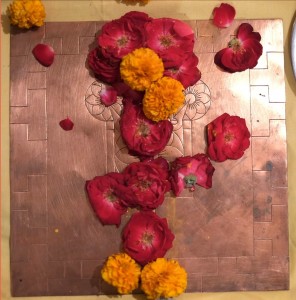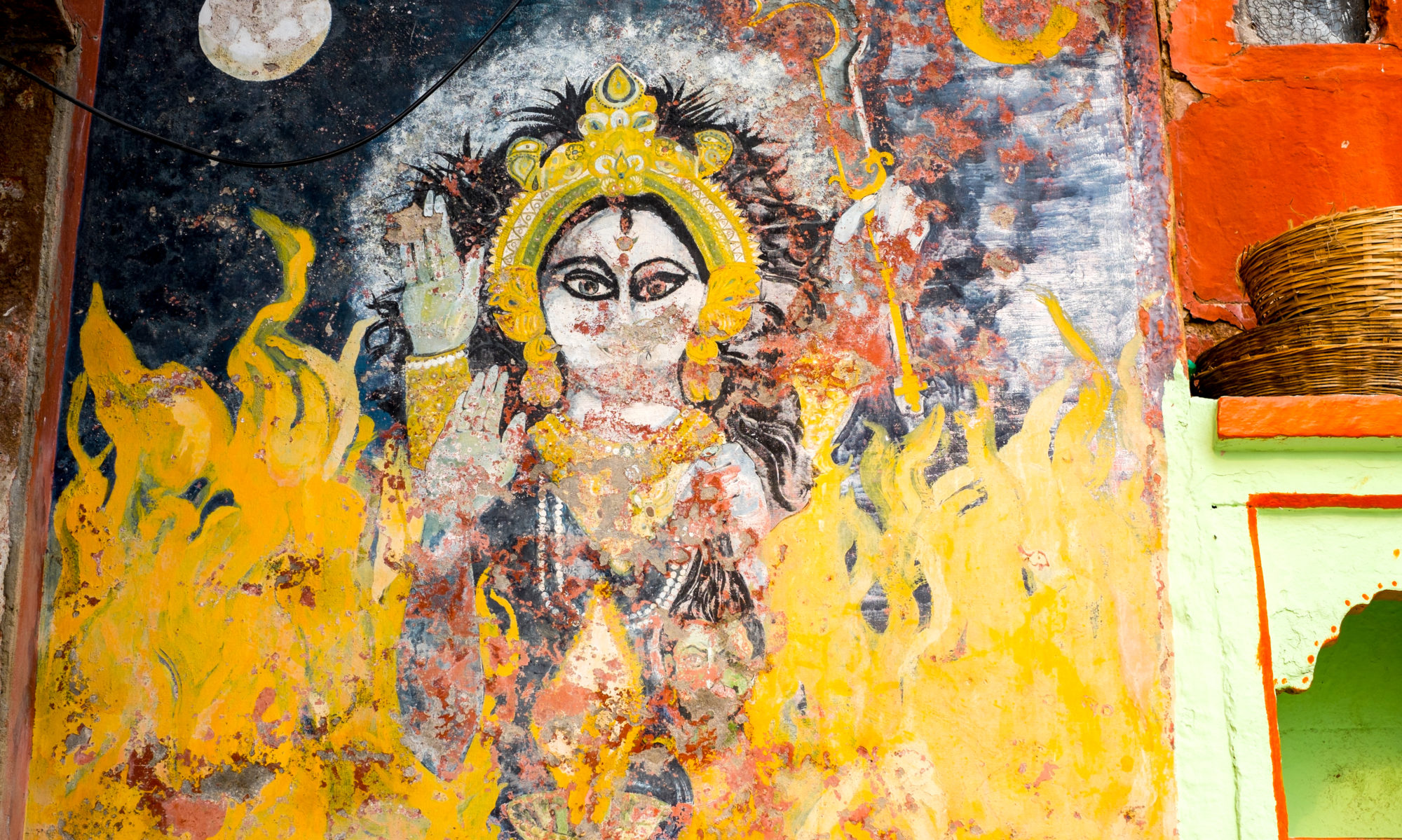KĀLACHAKRA AND THE 12 KĀLĪS: Time and Eternity.

The Dynamism of Movement and Rest, Becoming and Being, in the Oneness of Consciousness.
Movement and rest are the primary polarities of existence, whether physical, mental biological, or the one divine consciousness of which they are all manifestations. The complex multi-layered expansion of the actuality of the Present is motion in time, and the interrelation between each aspect of the wonderfully varied picture present within and through it, is their repose in space. Together, each distinct and yet inseparably one, movement and rest encompass every possibility and each actuality. Such is the Freedom of the act of Being, such is the sublime and wonderful expression of Shiva’s consciousness. As space, consciousness rests in its Being; as Time it unfolds in the perennial movement of Becoming. The interface between Being and Becoming is the One. The wonderfully interlocking multi-layered activity of consciousness rests within itself as the entire process in each and every of even the most tiny parts of its expansion. Awareness is the door that connects the mundane world of our individual existence in which we and all things are confined within their own fixed form, to a world of wonderful possibilities in which everything is like a mirror that reflects within itself the entire processless process of movement and rest, Becoming and Being. Thus whatever we observe attending to this Movement and Rest reveals in the clarity of the immediacy of awareness the Plenitude of the One. As Rumi so beautiful puts it:
“Oceans disappear and reappear,
Inside the pearl that you are.”
In two immersions to be held in August in Northern California–the first in Grass Valley and the next in San Francisco–we will learn about the many wonderful details of this dynamism and how to participate in it in two domains. In the first we will learn to observe the wonderful activity of the One in the cycle of the breath, the microcosm of the Wheel of Time; in the second we learn to recognize its activity in the domain of perception.
As the Master Abhinavagupta teaches:
Creation and absorption are established all together within the vital breath. This also (rests) within cognitive consciousness and that in pure consciousness, free of objectivity. Pure consciousness is the Goddess. She is Parā, the Supreme Goddess… Therefore, the essence of cognitive consciousness is, by its very nature, this (perpetual) pulsation. (This manifests) in the vital breath as the (countless) mergers and emergences (of all things). . . . This awareness of the wonderful diversity of action brought about by the power of Time is established in the pure will alone. Thus, in the outer world, (the power of Time) has no fixed form. We observe that even a tiny particle of time appears to be immense when we dream of dreaming, in a dream, in deep sleep, or when (immersed) in the sphere of thought, or in deep meditation, or when discerning (and contemplating) the process of withdrawal and creation of the universe. (TA 6/179-184)
The Wheel of Time and the Cycle of the Breath. Chapter Six of the Tantraloka.
As the following passages from the Atharvaveda so beautifully testify the Breath of Life and Time were experienced in India centuries before the Buddha at least three millennia
Praise to the Breath of Life!
He rules the world,
Master of all things,
On which all things are based. 1
Praise to you, Breath when you come
And praise when you go!
When you stand up
And when you sit still, to you praise. 7
Breath of Life is Queen, is guide,
Revered by all things;
He is sun, he is Moon
He is also the father of all. 12
—AV 10, 4 Prāṇasūktam
Time drives like a horse,
a thousand-eyed unaging Stallion.
Him the inspired poet mounts.
All beings are his chariot wheels.
Above time is a set a brimful vessel.
Simultaneously we see Time, here, there, everywhere.
Set face to face with all existences,
Time has gathered together all beings that are.
From time comes the Self-existent,
energy likewise from Time derives
–Pūrṇaḥ kumbhaḥ AV 19.53
Shining as all things, consciousness sparkles radiantly with its countless manifestations. Deployed and witnessed within it each one is all of it. A single process, it manifests in two aspects. One is the sequence of Space. This is the deployment of the worlds within the cosmic order and the body, which is taught in detail in chapter eight of the Tantraloka. The other is the sequence of Time. This is taught in chapter six. Just as the world orders, each with their own thickness, layered one upon the other, span the expanse of Space, so cycles of Time, small and extensive, span the Great Creation that encompasses them all. In the outer world time is measured by the cyclic procession of celestial beings embodied in the sun and moon, the planets and constellations. These were seen to correspond to the cycles of the breath.
The movement of the breath and its correspondence to the lunar cycle was perceived already in Vedic times and carried over into the Tantras centuries later. We find it extensively in the Tantra of the Three-headed Bhairava, an extensive and important work in Trika Tantra (sadly lost) that Abhinavagupta quotes often in his Tantrāloka. So too we find it the Tantras of the Kalikrama, which is as we would expect, as Kali is above all the embodiment of the power of time (kāla) which consumes and creates all things. But it is only in the Svacchandabhairavatantra, to which Abhinava refers as his main source, that we find its most extensive expression. Its clear and systematic exposition indicates that it is not amongst the earliest Bhairava Tantras. Moreover, it is a major source for several Tantras of several schools, amongst which is the Tantrasadbhāva, a Trika Tantra and the Tantras of the goddess Kubjikā that draw from here the same teachings regarding the Wheel of Time and the cycle of the breath. Although they fell into relative obscurity subsequently, there was period when they were popular. The yantra of Śrīvidyā is also a Wheel of Time, replete with the constellations and planets. Viṣṇu’s solar discus figures as such in the Vaiṣṇava Tantras. Most notable of all is the Buddhist Tantra and the school of which it is the prime authority, namely, Kālacakra, the Wheel of Time.
A day and a night, the waxing and waning lunar fortnights, the two halves of the year, cycles of sixty years, extending out into the breath and lifespans of the gods, all are mirrored in the cycle of the breath. Everyday we breath 21,600 times and with every breath, of only we knew it, we span the all these cycles of time. Here then is a method of observing the movement of the breath with great attention, a practice which can be said without a doubt to be amongst the most ancient and important of all in the religious traditions of India, one we find also in the other great religions of the world. We are taught not only to feel the flow of time in the breath but, above all, its origin and end in the juncture between, its ascending and descending phases. If they are Day and Night we are directed to dawn and sunset, midnight and midday; if they are the lunar fortnights the Full and New Moon. Particular important internally, as in the outer world are the eclipses, lunar and solar. If the cycle is the year the junctions are the solistices and so on. With the invaluable help of Freedom Cole, learned and renowned astrologer, we will trace these cosmic parallels in the breath, the Wheel of Time.
The Vision of the Eye: The Ascension and Transformation of Kaula Union and the Wheel of the Twelve Kālī. Chapter Four of the Tantrāloka.
In this immersion we examine the central teaching of chapter four of the Tantrāloka, which deals with the Empowered Means. Here we focus our attention on the polarities and phases of perception. Just as we attend to the phases of the cycle of the breath – where it begins, how it flows and where it comes to rest, similarly we learn to pay attention to the world outside and within, the activity of the senses and mind and ourselves as phases of the sacred dynamism of consciousness as it arises, persists, recedes, and encompasses all in transcendental oneness. In one of the most brilliant sections of the Tantrāloka, Abhinavagupta expounds the teachings of the Twelve Kālīs, who he presents as the hypostases of these phases. Significantly he introduces them as the twelve signs of the zodiac to remind us that each instant of perception is a moment of time and that Kālī is the power of time which is the inexplicable dynamism of consciousness. Their flow is the pulse of the Heart of consciousness which is the abode of Kālī who is Kālasaṁkarṣiṇī. Abhinava introduces these teachings which are at the very core and apex of Anuttara Trika with a beautiful and rich passage from the Yogasaṁcāra Tantra. It teaches how to wander (saṁcāra) through and out of the subtle body alone and with a partner. Transformed by the ascents and downward purifying flows of the essence of the bliss of the emission of the spiritual energy of Śiva consciousness, we learn to experience its outpouring from the body, senses and mind as that essence. Thus prepared we enter the dynamism of the Twelve Kālīs.
The dynamism of consciousness that manifests through the body as action, here manifests as the flow of the activity of the mind and senses especially the flow and resting of the breath. In all states of consciousness, whether awake, dreaming or even in deep sleep, every moment of our lives we are engaged in this activity.

